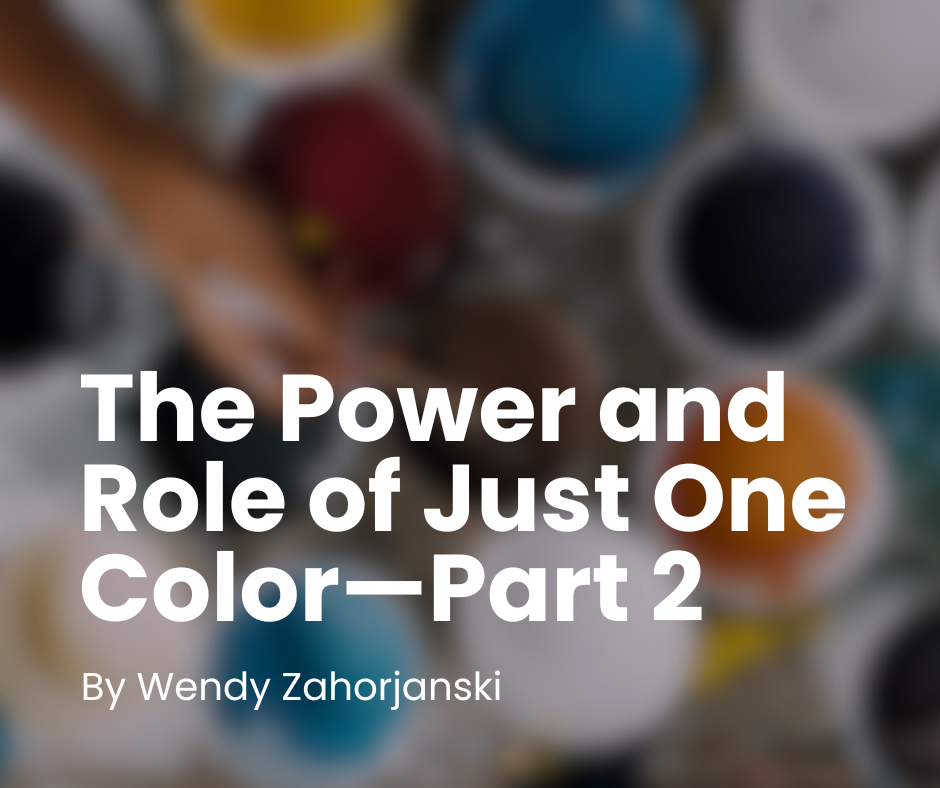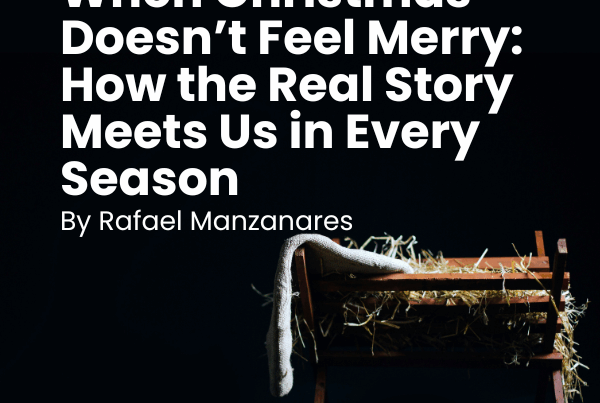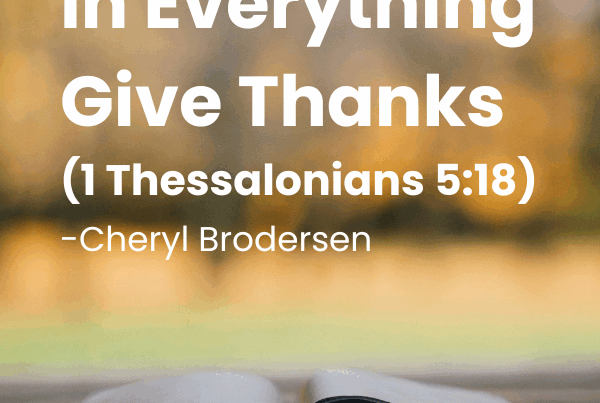
Editor’s Note: This is the second article in the Power and Role of Just One Color series. Click here to read the first article, published on February 6, 2024.
How can we become adept at recognizing our own gifts as well as those of local brothers and sisters?
This is one of the questions we asked in the first article of this series. Remember the monochromatic painting? I’m willing to bet that no great painter would stake his reputation on his ability to paint a masterpiece with just one color. It’d be silly, not to mention immature. That’s how small children color; it’s not how artists paint.
So Much Purple
I was teaching Sunday School last week, and at the end of class, we were each coloring a picture of the twelve disciples. I looked over at the little girl sitting next to me and noticed that she was coloring each disciple with the same purple colored pencil.
“Do you want to use a different color like green or red for these other disciples?” I asked.
“No, purple” was her reply, and that was that. She was leaving no doubt as to which color was her favorite.
I smiled.
I wasn’t baffled by her choice because she’s five and loves purple. Nothing out of the ordinary there. But imagine that instead of children, I was surrounded professional painters who’d been asked to recreate “The Last Supper” by Leonardo da Vinci. We start painting and I notice the guy next to me painted all the disciples purple. In the least, I would wonder, who let this guy in? (If this was a true story, by the way, I wouldn’t be there either. I can hold my own with five-year-olds, but adults are way out of my league.) This isn’t a real life example though, so I’m there. I would want to ask him why he chose to make them all look the same, and didn’t he know that representing them that way made them emotionless and one-dimensional? My thought might be, does he need more colors because I have some right here and will share? Does he need help with shading and mixing colors because there’re lots of artists here to ask for advice?
Using only purple wouldn’t make sense. As artists mature, so does their ability to combine just the right amount of each color to achieve the desired shade. They master seeing which white has grey undertones, which has yellow, and which is just white. They know what colors to pair together to create drama and tell a story.
Maybe it’s a cheesy example, but hopefully I’m driving home the ridiculousness of a mature person creating one-tone purple disciples.
Bringing in All the Colors
Scene shift: We’re sitting in church on Sunday morning, surrounded by modern disciples of Jesus. Real ones with blood pumping through their veins. Looking around the room, would you be able to pick out the gifts of those around you or would they all be purple generic disciples? I’m not suggesting that you need to know every gift of every person in your church, but of those who you know well, can you name them? Could they name yours?
If your answer is yes, that’s amazing. Keep leaning into each other’s gifts. Keep encouraging those around you to use their gifts.
If your answer was, “That’s a lot of purple.” Where do you start? How do we make sure that the church is full of each and every beautiful and essential color. Every gift we have testifies to the life and work of Jesus Christ and is indispensable to the health of the body as a whole. They point to the truth of the gospel that He embodied each in a unique way. Having vibrant, functioning gifts in the church is easier to talk about than to do. But it’s possible.
So how do we move out of being a purple mass and into discovering our own gifts and those of our brothers and sisters? This is a good question for friends to discuss over coffee. I’ll add my suggestions below, but don’t stop with mine. Grab some friends, a Bible, a beverage of choice, and brainstorm.
Time
Let’s get the hardest one out of the way. Our realities are stuffed with activities and appointments, so deliberately making rhythms that invest in friendships isn’t easy, and once the space is made, it still takes time for a relationship to deepen. Patiently waiting is something we aren’t used to. Sometimes friendships are jumpstarted by an intense, shared experience like a missions trip or college community living, or even a crisis, but usually it’s slow and steady. Years of earning trust and giving it. As we share life with our church family, we also share our gifts. They become revealed over time to others and to ourselves, if there’s room for that kind of sharing. I think that recognizing our gifts often happens like this. Sometimes a person has a very obvious gifting that smacks you in the face when you meet them, but for the rest of us, time is needed to peel back the layers.
Then, as time goes on and gifts are revealed, an amazing opportunity unfolds before the church: The chance to confirm the gifts that have come to the surface. The example of this that comes to my mind is in Acts 13 when Paul and Barnabas were separated out by the Holy Spirit and sent on their first missionary journey. Verse one reveals that a small group of men were prophets and teachers, Paul and Barnabas being included among them, and they were praying and fasting when the Lord spoke. Their gifts were already recognized by their fellow brothers and then confirmed by the laying on of hands. How encouraging it is when someone who knows us well says, “Yes, I see that you have that gift. You should totally go and use it.”
Love
Another thing essential to recognizing our own and others’ giftings is love. This might be just as hard as the time one; no one said this would be easy. 1 Corinthians offers the big picture of the purpose of our gifts. It tells us that they’re an outpouring of love, to benefit each other and build up each other. I haven’t been given the gift of leadership in order to get ahead or to make a name for myself. I have that gift in order to stir up, inspire, and guide my brothers and sisters to worship. Not worship me, but our Lord. Love infuses our gifts with life-giving power and humility. It frees us from our obsession to look out for number one. It makes leadership kind, giving meek, prophecy selfless, and miracles without envy.
It teaches us to pray, “What role would you have me play in this situation? What gifts are needed? Do I have any of them? If not, who does and how can my giftings empower theirs in this situation?” We don’t always need to be main participants for our gifts to be used for the building up of the church. The supporting gifts are just as vital as the ones they’re holding up, and the beautiful thing is that these positions constantly change. Preaching might be the gift on display during a sermon, but the moment it’s over, other gifts like knowledge, exhortation, and evangelism might take center stage as they work the message into the hearts of the hearers. Then comes mercy to walk beside them and hospitality to welcome them back again, prophecy to clarify, miracles to restore. I could go on. The spotlight of the church should be constantly rotating to highlight the gift that is more appropriate for each given situation.
Humility
The last essential that came to my mind was humility; knowing what we are and what we aren’t. In this context, knowing which gifts we have and which we don’t.
A friend of mine is going through a huge life transition and the idea of working through the changes with someone in the form of debrief came up as we were talking. She expressed a desire to be debriefed, but didn’t know anyone who could do it. Everything in me was screaming, “I will! I can!”
The first part of that cry was true, but not the second. I have zero training in debriefing. I can’t debrief someone in the official sense of that word. I can be a friend, but she needed someone who knew what they were doing, and I wasn’t it. It was a rare time in my life that I actually recognized my limitations. I triumphantly came home and declared, “I was at ___’s house and she needs to be debriefed. I wanted to volunteer myself, but didn’t.” Part of knowing our gifts is knowing what they aren’t.
There has to be a pause here for a warning. Let’s not get lazy and use that as an excuse to disobey. “Oh I don’t have the gift of evangelism (I really don’t), so I can’t just share the gospel with someone.” No go, sister. Every believer is called to be able and ready to share the hope that’s in them (1 Peter 3:15). That hope is Jesus, and talking about Him will inevitably lead you to share the gospel. Recognizing the lack of a certain gift isn’t the same as avoiding an uncomfortable situation or an uncomfortable aspect of the Christian life.
A healthy way of seeing what we’re not looks like this: Let’s say the church needs an office administrator and your name comes up. You know that’s not one of your gifts nor do you have the skill-set to match that gift, so you graciously decline. This isn’t disobedience; it’s discernment.
Unsure if you’re in the first or second situation? Ask! Trusted, mature believers often see things that we miss.
And go back to love. Would it be loving to take a position that I’m not gifted or qualified for? I’m probably going to leave a mess behind me that someone else will have straighten out. On the other hand, would it be loving to try to share the love of Christ with someone even if my methods or words are clunky and awkward? Yes, it would. Filter the situation through love. Would it be loving, or insert the definition of love from 1 Corinthians 13, and say, “Would it be patient, kind, etc., to do or not do this thing?”
One other question to ask is this: Is this an opportunity for me to develop a new skill and improve in an area that’s not my natural gifting? I’ve grown so much in areas that I’m not naturally gifted in by having friends who are gifted in those things and learning from them. Like my friend from the first article. Even though I don’t have the gift of discerning spirits to the degree that I can sense demonic activity in a room, I’ve learned new skills in that area that help me. My brothers and sisters have taught me how to ask certain questions, look for certain behaviors, and process a situation with them after. All of these have encouraged me and built me up to face situations that are outside of my gifting. They’ve taught me that I can grow and that I’m not alone in the process.
Spiritual gifts, when used and mixed together, create a masterpiece. And a curious thing happens when you look at the picture as a whole. No one color dominates. They all work together to point to the bigger picture: the subject of the painting, Jesus Christ.
Next Time
We will dive into the next two questions:
-How can we, as a church, facilitate opportunities for gifts to develop?
-How can we use our gifts to work together, strengthening and encouraging, instead of being threatened by, or competing with, each other?







